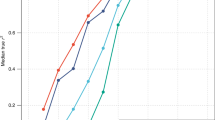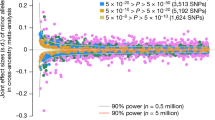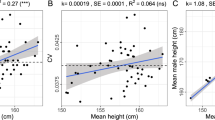Abstract
Human height is a classic, highly heritable quantitative trait. To begin to identify genetic variants influencing height, we examined genome-wide association data from 4,921 individuals. Common variants in the HMGA2 oncogene, exemplified by rs1042725, were associated with height (P = 4 × 10−8). HMGA2 is also a strong biological candidate for height, as rare, severe mutations in this gene alter body size in mice and humans, so we tested rs1042725 in additional samples. We confirmed the association in 19,064 adults from four further studies (P = 3 × 10−11, overall P = 4 × 10−16, including the genome-wide association data). We also observed the association in children (P = 1 × 10−6, N = 6,827) and a tall/short case-control study (P = 4 × 10−6, N = 3,207). We estimate that rs1042725 explains ∼0.3% of population variation in height (∼0.4 cm increased adult height per C allele). There are few examples of common genetic variants reproducibly associated with human quantitativetraits; these results represent, to our knowledge, the first consistently replicated association with adult and childhood height.
This is a preview of subscription content, access via your institution
Access options
Subscribe to this journal
Receive 12 print issues and online access
$209.00 per year
only $17.42 per issue
Buy this article
- Purchase on Springer Link
- Instant access to full article PDF
Prices may be subject to local taxes which are calculated during checkout


Similar content being viewed by others
References
Fisher, R.A. The correlation between relatives on the supposition of mendelian inheritance. Trans. R. Soc. Edinburgh, 399–433 (1918).
Macgregor, S., Cornes, B.K., Martin, N.G. & Visscher, P.M. Bias, precision and heritability of self-reported and clinically measured height in Australian twins. Hum. Genet. 120, 571–580 (2006).
Preece, M.A. The genetic contribution to stature. Horm. Res. 45, 56–58 (1996).
Silventoinen, K., Kaprio, J., Lahelma, E. & Koskenvuo, M. Relative effect of genetic and environmental factors on body height: Differences across birth cohorts among Finnish men and women. Am. J. Public Health 90, 627–630 (2000).
Silventoinen, K. et al. Heritability of adult body height: A comparative study of twin cohorts in eight countries. Twin Res. 6, 399–408 (2003).
Perola, M. et al. Combined genome scans for body stature in 6,602 European twins: evidence for common Caucasian loci. PLoS Genet. 3, e97 (2007) (doi:10.1371/journal.pgen.0030097).
Palmert, M.R. & Hirschhorn, J.N. Genetic approaches to stature, pubertal timing, and other complex traits. Mol. Genet. Metab. 80, 1–10 (2003).
Davey Smith, G. et al. Height and risk of death among men and women: aetiological implications of associations with cardiorespiratory disease and cancer mortality. J. Epidemiol. Community Health 54, 97–103 (2000).
Gunnell, D. et al. Height, leg length, and cancer risk: A systematic review. Epidemiol. Rev. 23, 313–342 (2001).
Wellcome Trust Case Control Consortium. Genome-wide association study of 14,000 cases of seven common diseases and 3,000 shared controls. Nature 447, 661–678 (2007).
Diabetes Genetics Initiative of Broad Institute of Harvard and MIT et al.. Genome-wide association analysis identifies loci for type 2 diabetes and triglyceride levels. Science 316, 1331–1336 (2007).
Campbell, C.D. et al. Demonstrating stratification in a European American population. Nat. Genet. 37, 868–872 (2005).
Clayton, D.G. et al. Population structure, differential bias and genomic control in a large-scale, case-control association study. Nat. Genet. 37, 1243–1246 (2005).
Price, A.L. et al. Principal components analysis corrects for stratification in genome-wide association studies. Nat. Genet. 38, 904–909 (2006).
Devlin, B. & Roeder, K. Genomic control for association studies. Biometrics 55, 997–1004 (1999).
Zhou, X., Benson, K.F., Ashar, H.R. & Chada, K. Mutation responsible for the mouse pygmy phenotype in the developmentally regulated factor HMGI-C. Nature 376, 771–774 (1995).
Battista, S. et al. The expression of a truncated HMGI-C gene induces gigantism associated with lipomatosis. Cancer Res. 59, 4793–4797 (1999).
Ruyter-Spira, C.P. et al. The HMGI-C gene is a likely candidate for the autosomal dwarf locus in the chicken. J. Hered. 89, 295–300 (1998).
Ligon, A.H. et al. Constitutional rearrangement of the architectural factor HMGA2: a novel human phenotype including overgrowth and lipomas. Am. J. Hum. Genet. 76, 340–348 (2005).
Higgins, J.P., Thompson, S.G., Deeks, J.J. & Altman, D.G. Measuring inconsistency in meta-analyses. Br. Med. J. 327, 557–560 (2003).
Hock, R., Furusawa, T., Ueda, T. & Bustin, M. HMG chromosomal proteins in development and disease. Trends Cell Biol. 17, 72–79 (2007).
Lohmueller, K.E., Pearce, C.L., Pike, M., Lander, E.S. & Hirschhorn, J.N. Meta-analysis of genetic association studies supports a contribution of common variants to susceptibility to common disease. Nat. Genet. 33, 177–182 (2003).
Mills, G.W. et al. Heritability estimates for beta cell function and features of the insulin resistance syndrome in UK families with an increased susceptibility to type 2 diabetes. Diabetologia 47, 732–738 (2004).
Zeggini, E. et al. Replication of genome-wide association signals in UK samples reveals risk loci for type 2 diabetes. Science 316, 1336–1341 (2007).
Golding, J., Pembrey, M. & Jones, R. ALSPAC–the Avon Longitudinal Study of Parents and Children. I: study methodology. Paediatr. Perinat. Epidemiol. 15, 74–87 (2001).
Rogers, I.S. et al. Associations of size at birth and dual-energy X-ray absorptiometry measures of lean and fat mass at 9 to 10 y of age. Am. J. Clin. Nutr. 84, 739–747 (2006).
Leary, S.D. et al. Smoking during pregnancy and offspring fat and lean mass in childhood. Obesity (Silver Spring) 14, 2284–2293 (2006).
Knight, B., Shields, B.M. & Hattersley, A.T. The Exeter Family Study of Childhood Health (EFSOCH): study protocol and methodology. Paediatr. Perinat. Epidemiol. 20, 172–179 (2006).
Vartiainen, E. et al. Cardiovascular risk factor changes in Finland, 1972–1997. Int. J. Epidemiol. 29, 49–56 (2000).
Purcell, S. et al. PLINK: a toolset for whole-genome association and population-based linkage analysis. Am. J. Hum. Genet. 81, 559–575 (2007).
Acknowledgements
For the UK-based studies, collection of the type 2 diabetes cases was supported by Diabetes UK, BDA Research and the UK Medical Research Council (MRC) (Biomedical Collections Strategic Grant G0000649). The UK Type 2 Diabetes Genetics Consortium collection was supported by the Wellcome Trust (Biomedical Collections Grant GR072960). The ALSPAC study was supported by The UK MRC, the Wellcome Trust and the University of Bristol. The Exeter Family Study of Childhood Health was supported by UK National Health Service Research and Development and the Wellcome Trust. We also thank the Exeter University Foundation for funding. The UK GWA genotyping was supported by the Wellcome Trust (076113), and replication genotyping was supported by the Wellcome Trust, Diabetes UK, European Commission (EURODIA LSHG-CT-2004-518153) and the Peninsula Medical School. Personal funding comes from the Wellcome Trust (A.T.H.; Research Leave Fellow; Research Career Development Fellow); UK MRC (J.R.B.P.); Diabetes UK (R.M.F.) and the Throne-Holst Foundation (C.M.L.). M.N.W. is Vandervell Foundation Research Fellow at the Peninsula Medical School. C.M.L. is a University of Oxford Nuffield Department of Medicine Scientific Leader Fellow. C.N.A.P. and A.D.M. are supported by the Scottish executive as part of the Generation Scotland Initiative. We acknowledge the assistance of many colleagues involved in sample collection, phenotyping and DNA extraction in all the different studies. We thank K. Parnell, C. Kimber, A. Murray and K. Northstone for technical assistance. We thank S. Howell, M. Murphy and A. Wilson (Diabetes UK) for their long-term support for these studies. We also acknowledge the efforts of J. Collier, P. Robinson, S. Asquith and others at KBiosciences for their rapid and accurate large-scale genotyping. Finally, we acknowledge all participants in the various studies.
For the studies using the Scandinavian, US and Polish samples, the work was supported by a March of Dimes grant (#6-FY04-61) to J.N.H. and by a grant from The Center of Excellence in Complex Disease Genetics of the Academy of Finland (EU Projects GenomEUtwin, QLG2-CT-2002-01254) (L.P.). The FINRISK study was supported by the Sigrid Juselius Foundation. We thank members of our laboratories and of the Altshuler and Daly laboratories for helpful discussion, and we gratefully acknowledge all of the participants in the studies. We also thank J. Butler for excellent technical assistance and M. Kuokkanen for logistical help with the FINRISK97 cohort.
The whole-genome genotyping and analysis in the DGI genome scan (see Supplementary Note online for contributors) was supported by Novartis Institutes for BioMedical Research (to D. Altshuler), with additional support from The Richard and Susan Smith Family Foundation/American Diabetes Association Pinnacle Program Project Award (to D. Altshuler, J.N.H. and M.J. Daly). R.S. is supported by a US National Institutes of Health (NIH) Research Service Award. G.L. is supported by a March of Dimes research grant (6-FY04-61). Members of the DGI study group acknowledge support from an NIH/National Heart, Lung, and Blood Institute grant (U01 HG004171), the Burroughs Wellcome Fund and the Doris Duke Charitable Foundation. L.C.G. and members of the Botnia Study were funded by the Sigrid Juselius Foundation, the Finnish Diabetes Research Foundation, the Folkhalsan Research Foundation and Clinical Research Institute HUCH. The Malmö Study was funded by a Linné grant from the Swedish Research Council. L.C.G. is supported principally by the Sigrid Juselius Foundation, the Finnish Diabetes Research Foundation, The Folkhalsan Research Foundation and Clinical Research Institute HUCH. Work in Malmö, Sweden was also funded by a Linné grant from the Swedish Research Council. We thank the Botnia and Skara research teams for clinical contributions, and colleagues at Massachusetts General Hospital, Harvard, Broad and Novartis for discussions.
Author information
Authors and Affiliations
Consortia
Contributions
Members of the WTCCC and DGI are listed in the Supplementary Note. M.N.W., G.L., R.M.F. and C.M.L. performed the analyses and wrote the first draft of the paper. J.R.B.P., K.S.E., B.S., E.Z., H.L., N.J.T. and N.W.R. were responsible for production, quality control and cleaning of the GWA data from the WTCCC samples. B.F.V., C.G., V.L., N.P.B. and R.S. were responsible for the production, quality control checking and cleaning of the GWA data from the DGI samples. B.F.V. also performed association testing and EIGENSTRAT analyses for height on the DGI data set. S.M.R. performed the data linking and quality control analysis for the ALSPAC study. R.H. and C.G. genotyped rs1042725 in the FINRISK97 cohort. K.A. is principal investigator for the near-extreme height panel. L.P. and V.S. are principal investigators for FINRISK97. L.C.G. is principal investigator for the Botnia study. G.D.S. is principal investigator of the ALSPAC study. J.H.T. and A.R.N. generated DXA measures in the ALSPAC children. C.N.A.P. and A.D.M. are principal investigators of the Tayside UKT2D-GCC study. A.T.H., M.I.M., J.N.H. and T.M.F. designed and led the study. All authors read and approved the final manuscript.
Corresponding author
Supplementary information
Supplementary Text and Figures
Supplementary Tables 1–6, Supplementary Methods, Supplementary Note (PDF 100 kb)
Rights and permissions
About this article
Cite this article
Weedon, M., Lettre, G., Freathy, R. et al. A common variant of HMGA2 is associated with adult and childhood height in the general population. Nat Genet 39, 1245–1250 (2007). https://doi.org/10.1038/ng2121
Received:
Accepted:
Published:
Issue Date:
DOI: https://doi.org/10.1038/ng2121
This article is cited by
-
High-throughput DNA sequence analysis elucidates novel insight into the genetic basis of adaptation in local sheep
Tropical Animal Health and Production (2024)
-
Genomic insight into the influence of selection, crossbreeding, and geography on population structure in poultry
Genetics Selection Evolution (2023)
-
Impact of Type 2 Diabetes Mellitus-Related Factors on Glaucoma: a Comprehensive Review
Current Ophthalmology Reports (2023)
-
Global dispersal and adaptive evolution of domestic cattle: a genomic perspective
Stress Biology (2023)
-
Genomic diversity and signatures of selection in meat and fancy rabbit breeds based on high-density marker data
Genetics Selection Evolution (2022)



